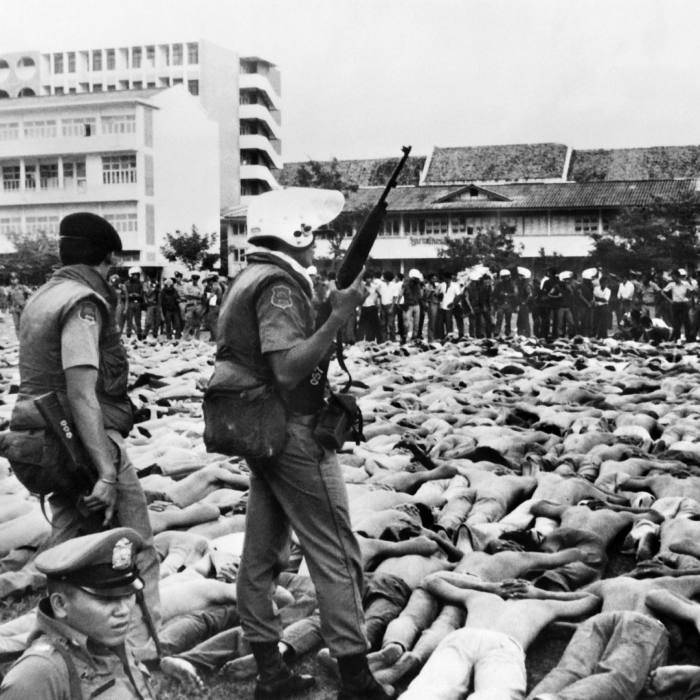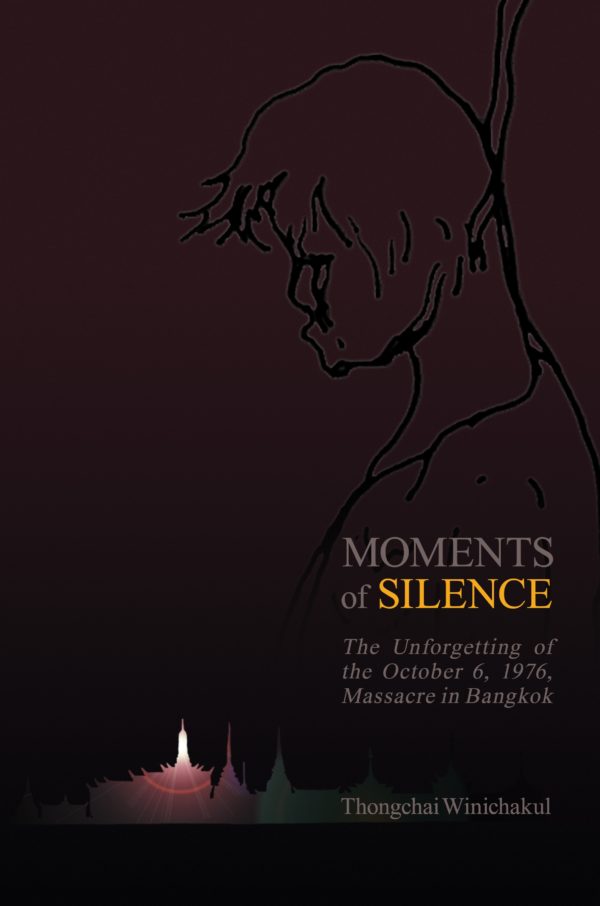‘Smashing the ceiling’ of the unforgetting of the October 6 massacre in Bangkok

On October 6, 1976, the police and paramilitary groups stormed into Thammasat University in Bangkok where thousands were gathering to protest the attempt to return to military rule. It was the tragic finale of the three-year democratisation after the student uprising in 1973 had ended the military rule that governed the country most of the time since 1947. More than forty people were killed and three thousand were put in jail.
But what made the October 6 carnage even more traumatic was its brutality that included several public hangings, dragging by the neck, sexual assaults, and heinous desecration of the corpses. There has never been an investigation into the atrocity that happened on that day.
My latest book, Moments of Silence: The Unforgetting of the October 6, 1976, Massacre in Bangkok (University of Hawai`i, 2020) (MoS) is not much the account of what happened. Instead, the ten chapters of MoS are a history of silence that has surrounded the atrocity, and the changing conditions and reasons for such silence over forty years afterward. The book is not a memoir either, although I inform the readers what I had witnessed on that day in 1976 and my role in the efforts to break the silence in subsequent decades.
Silence is not forgetting. It is the unforgetting—the inability to remember or forget, the difficulty to articulate memories in a meaningful way to others especially to the public. Those moments of unforgetting are telling testimonies not only about the tragedy but far more about Thai society.
The obvious reason for the unforgetting in this case was political. The most important one was the dubious role of the monarchy and the Buddhist Order in the massacre. The repercussions of truth about the massacre is, therefore, unimaginable for Thailand, whether then or now. Over forty years, changing political conditions also affected social memories and silence in various ways, namely, the peak of the domestic Cold War in the late 1970s and its end in the early 1980s, and democratisation in the 1980s and 1990s. Under these conditions, the victims, the perpetrators, and even the public, were in shame, guilt, and ambivalence for different reasons, all resulting in silence despite their diverse politics.
In 2016, the fortieth anniversary of the massacre, many families of the victims, as well as the public in general, still remained silent because the issue was still, in their words, too ‘sensitive’ (la-iad on) to discuss. As the public sympathised with the victims, the perpetrators turned silent, even though most of them have lived on with pride and without remorse.
But all these political factors are easier to understand. The subtler and often harder factors are the ideological and cultural ones, especially royal-nationalism and hyper-royalism in Thailand’s everyday culture, as well as the dominant historical ideology and Buddhism. They have contributed to the public discourses related to the memories of the massacre, such as reconciliation, harmony, history, truth, justice, and so on. The weak rule of law with the state’s impunity is also an important factor. Altogether, hence, the inability to articulate memories of the massacre—the unforgetting.
Nonetheless, sometimes silence nourishes the living souls, as in the story of parents who kept hope for the return of their son as long as his body was not found. Sadly, this hopeful silence was fragile. In another case, silence was a form of protesting voice—a mute soliloquy.
Silence has been broken to some degree during the four decades, thanks to the efforts to remember the event and to promote political tolerance. But the ‘who and why’ of the 1976 massacre remain off limits. Four decades afterward, there has never been an investigation into the atrocity. The October 6 massacre is still haunting, mostly as cryptic appearances without a description, in novels, films, political cartoons, arts, even in a recent music video of a rap song, which millions have seen.
To my astonishment, only a few months after MoS was released in 2020, the limits of the massacre memories were pushed significantly. Had the book been written a few years later, Chapter 11 ‘Smashing the ceiling of silence’ would have been added, with the opening paragraph as below.
‘On August 10, 2020, at the gathering at Thammasat University to protest the palace-backed government of General Prayuth Chan-o-cha, the protesters showed the film clippings of the October 6 massacre in 1976 on the huge back-stage LCD screen. Thousands of people there, plus many thousand followers on-line, saw the brutality forty-four years earlier together. Since the clippings have been available widespread for some years, many might have seen it before. But the display this time was different. The marching song soundtrack of the clippings was muted. Instead, a well-known song composed by King Bhumibol was playing alongside the pictures of the killings. No narration and no explanation were given as to why this song was used for the clippings even though they seemed unrelated; or were even at odds with one another. After the intriguing spectacle, a protest leader read the “10-point demands” for the reform of the monarchy without a word about the clippings or the song. Despite that, some of my old friends who survived the massacre in 1976 shed tears. The silent connection between the sight and the sound had strikingly pushed the limits of the unforgetting of the massacre.’
The October 6 massacre is one of the best incidences that exposes the state’s impunity and the monarchy’s power even though the king formally has none. The unforgetting of the massacre is also a testament to how the state controls social memory and instills fear in the name of reconciliation and harmony. The cinematic memory of the massacre in tandem with the royal composition formed a silent narrative of the massacre that has never been told in public. To raise the curtain of the campaign for the reform of the monarchy in this way, the young protesters unmistakably sent a loud and clear message, without having to say a word, that the monarchy in Thai politics is no longer off limits.
The Gen Z and the millennials in Thailand grew up with several coups and political crises, and under the palace-backed authoritarian regimes since the mid-2000s. In their young lives, political suppressions, including the abuse of laws and forced appearances, have been daily news. They are cognisant that hundreds of critics of the government have been put in jail, dozens exiled, and some have simply vanished. Meanwhile the country’s economy and the material life of ordinary people have deteriorated in contrast with the rapidly increasing affluence of the rich and those with privileges, particularly the royal family which lives an extravagant and over-indulging lifestyle off public resources. Bad politics and the royalist regimes have rapidly diminished a hopeful future for these young people. The youth movement resolves to take back their future.
On the other hand, unlike most adults of older generations, these youths grew up during the weakening hyper-royalism in the past decade and a half. Their reservations about the monarchy are not ideological but are critical reactions to hyper-royalism that deifies the monarchy despite scandalous comportments and abuses of power by the royals. Most importantly, hyper-royalism has been the basis for the suffocating authoritarian culture in schools and in the society at large, from their young ages and likely throughout their lives—if they do not do anything.
The October 6 massacre also reminds them of the atrocious situation that people in the previous generations had endured. Hence, the determination of the youths to ‘end it in our generation’, as they declare in public, with ‘it’ meaning the coalition of the military and the monarchy for authoritarianism. In calling for the end of the royalist authoritarian rule and for the reform of the monarchy, the young generations have spoken loudly, in words and by their actions, that they are not afraid and would not be bound by the limits of the unforgetting of the massacre. Not any longer. To accept the ‘ceiling’, as they called it, or to smash it through, at stake is their future.
Thongchai Winichakul is Emeritus Professor of History at University of Wisconsin-Madison and former ARI Senior Research Fellow (2010-2012).
The views expressed in this forum are those of the individual authors and do not represent the views of the Asia Research Institute, National University of Singapore, or the institutions to which the authors are attached.
Silence is not forgetting. It is the unforgetting—the inability to remember or forget, the difficulty to articulate memories in a meaningful way to others especially to the public. Those moments of unforgetting are telling testimonies not only about the tragedy but far more about Thai society.







